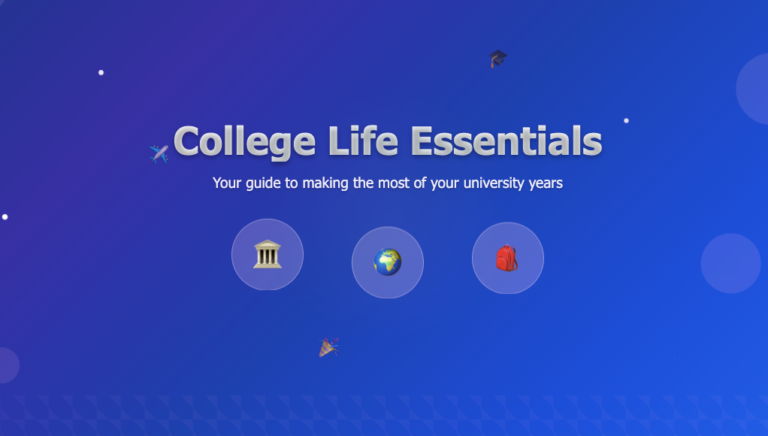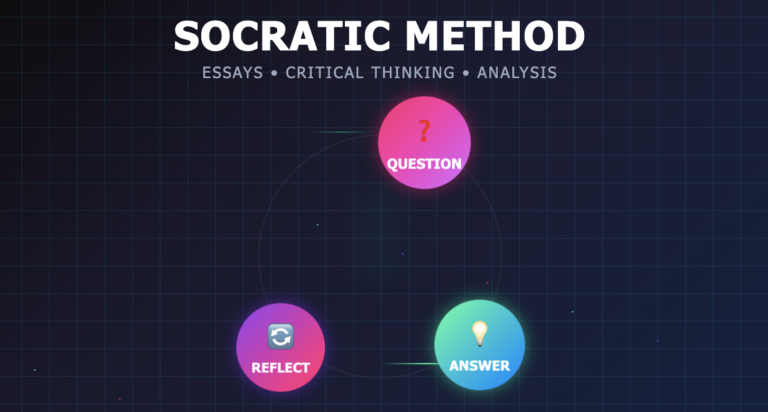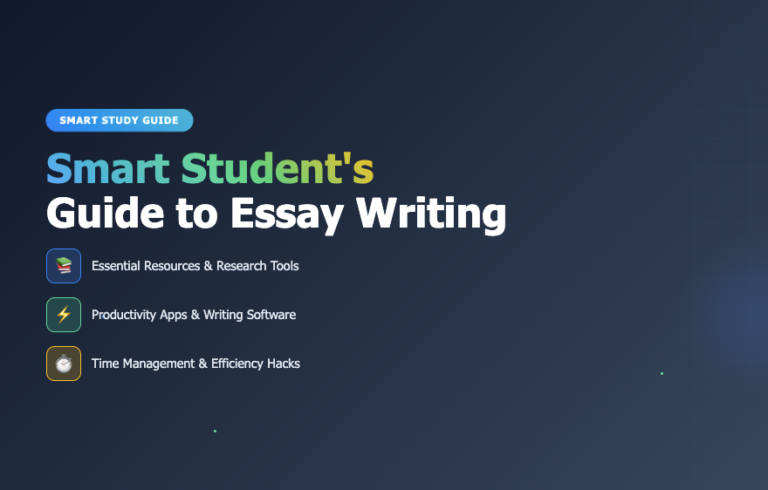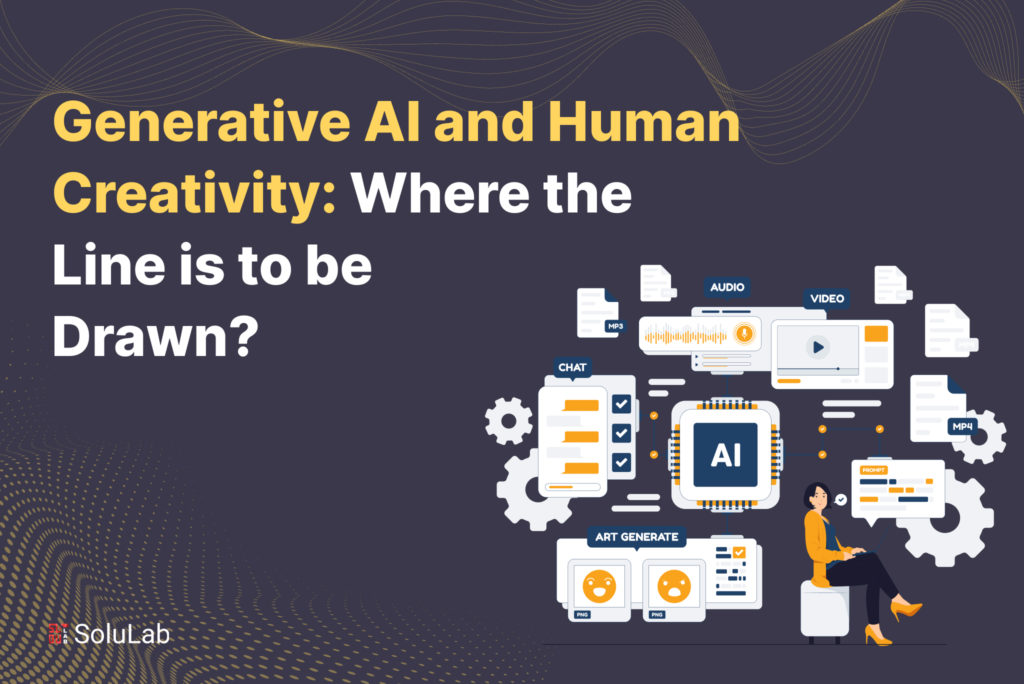
Generative AI, at its core, refers to a subset of Artificial intelligence (AI) that focuses on creating rather than merely processing data. It stands as a testament to the relentless evolution of technology, transforming the way we perceive and harness AI capabilities.
The evolution of Generative AI technology has been marked by significant milestones, from early experiments to the current era of advanced models. The journey involves the continuous refinement of algorithms, the introduction of deep learning techniques, and the exploration of novel architectures that enhance the generative capabilities of AI.
In the broader technological landscape, Generative AI holds immense significance, particularly in fostering a dynamic relationship between machines and human creativity. By enabling the creation of content that mirrors human-like expression, Generative AI becomes a powerful tool for artists, writers, and innovators seeking new avenues for creative exploration.
What Impact of Generative Al on Creativity?
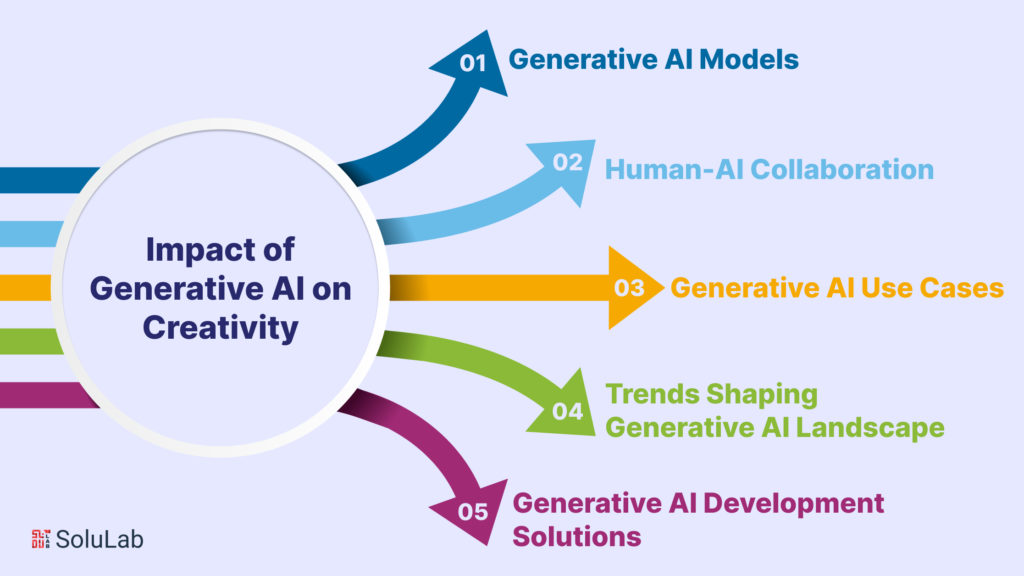
The advent of Generative AI technology has ushered in a transformative era for creativity, profoundly impacting the creative process through its sophisticated models and collaborative potential.
-
Generative AI Models
Generative AI models, powered by advanced algorithms and neural networks, have become veritable engines of creativity. These models possess the capability to analyze vast datasets and generate content autonomously, mimicking and often surpassing human-like creative outputs. This impact is most evident in fields such as art, design, and content creation, where Generative AI models contribute novel perspectives, styles, and ideas that augment the creative repertoire.
-
Human-AI Collaboration
The intersection of Generative AI and human creativity unfolds in a dynamic collaboration. This synergy is not about replacing human creativity but enhancing it. Generative AI and Human-AI collaboration become a symbiotic relationship where Generative AI acts as a co-creator, aiding humans in ideation, suggesting alternative solutions, and automating routine tasks. This collaboration amplifies efficiency, allowing creatives to focus on high-level thinking and innovation.
-
Generative AI Use Cases
The impact of Generative AI extends across diverse use cases. In fields like graphic design, Generative AI tools assist in rapid prototyping and ideation. In content creation, language models generate coherent and contextually relevant text. In healthcare, Generative AI aids in drug discovery and medical imaging interpretation. The breadth of applications showcases the versatility of Generative AI in catalyzing creativity across industries.
-
Trends Shaping Generative AI Landscape
The Generative AI landscape is marked by dynamic trends. Continuous advancements in algorithms, increased computing power, and improved datasets contribute to the evolution of Generative AI models. Ethical considerations, responsible AI deployment, and transparency are becoming pivotal trends, reflecting a growing awareness of the societal impact of Generative AI.
-
Generative AI Development Solutions
Navigating the complexities of Generative AI development requires tailored solutions. Specialized Generative AI development companies play a crucial role in providing expertise, from algorithmic development to ethical considerations. These solutions ensure responsible and effective integration of Generative AI into existing workflows.
How to Analyze the Intersection of Generative Al and Human Creativity?
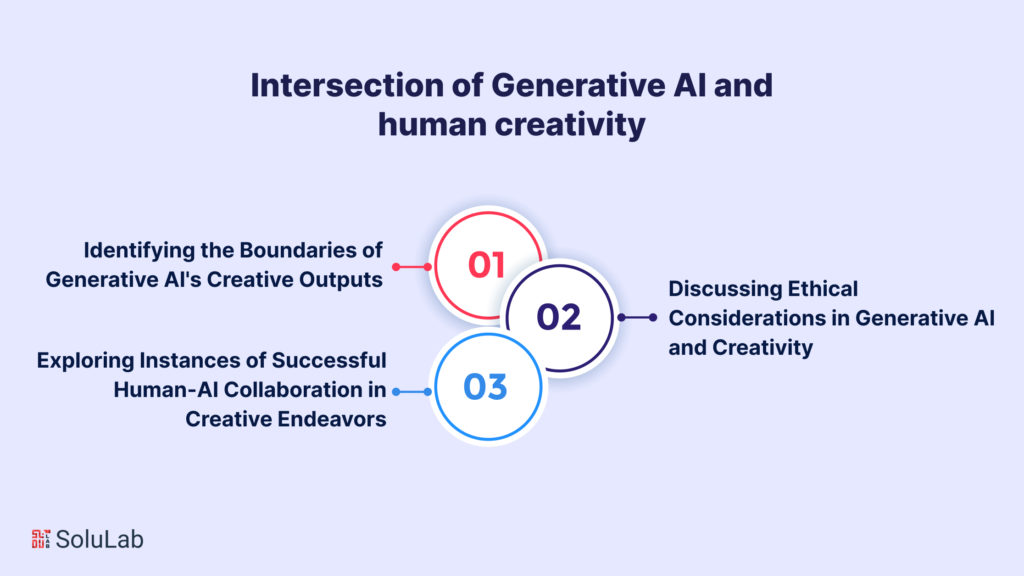
Generative AI, a powerful technological force, intersects with human creativity, sparking a nuanced exploration of boundaries, ethics, and collaborative potentials.
-
Identifying the Boundaries of Generative AI’s Creative Outputs
Generative AI, while capable of producing impressive creative outputs, operates within defined limits. Understanding these boundaries is crucial to harness its potential responsibly. By deciphering the extent of AI-generated creativity, we ensure harmonious integration without overshadowing the human touch.
-
Discussing Ethical Considerations in Generative AI and Creativity
The fusion of Generative AI and creativity introduces ethical dimensions. Delving into questions of authorship, intellectual property, and the unintended consequences of AI-generated content is imperative. Striking a balance between innovation and ethical integrity safeguards against potential pitfalls in the evolving landscape of AI-driven creativity.
-
Exploring Instances of Successful Human-AI Collaboration in Creative Endeavors
Examining instances where Generative AI collaborates with human creatives reveals the potential for groundbreaking synergy. From aiding artists in ideation to assisting writers in content creation, these collaborations showcase the harmonious coexistence of technology and human intuition. Such success stories serve as beacons guiding the path toward fruitful partnerships.
What are the Current Trends that are Shaping the Generative AI Landscape?
The current trends in the Generative AI landscape reflect a dynamic interplay between technology, creativity, and collaborative efforts, shaping the way we approach problem-solving and innovation.
Generative AI technology has witnessed a surge in advancements, with cutting-edge tools and models driving the landscape’s evolution. These technologies are not merely computational tools; they’ve become enablers of creativity, unlocking novel possibilities across various industries.
Generative AI and human creativity are converging, fostering a symbiotic relationship where AI acts as a catalyst for human ingenuity. This collaboration is particularly evident in fields like art, design, and content creation, where Generative AI tools serve as creative assistants, augmenting human capabilities and pushing the boundaries of what’s achievable.
The proliferation of Generative AI tools is influencing diverse use cases. From generating realistic AI images to aiding in complex decision-making processes, these tools are proving versatile across sectors such as healthcare, finance, and entertainment. The adaptability of Generative AI models ensures their relevance in addressing a broad spectrum of challenges.
With expertise in Generative AI technology, SoluLab provides comprehensive Generative AI consulting services that encompass strategic planning, implementation, and ongoing support. The company recognizes the critical intersection of Generative AI and human creativity, and its consulting services are designed to facilitate a seamless integration that enhances creative processes across industries.
What are the Challenges in Generative AI Development and Potential Solutions?
Developing Generative AI poses several challenges, reflecting the intricate nature of merging technology and human creativity.
-
Complexity of Generative AI Model
Challenge: Building sophisticated Generative AI models requires a deep understanding of complex algorithms and neural networks.
Solution: Continuous research and collaboration among developers to simplify model architectures and enhance accessibility.
-
Ethical Concerns in Creativity
Challenge: Striking a balance between Generative AI’s creative outputs and ethical considerations is challenging.
Solution: Implementing robust ethical guidelines, involving diverse perspectives in development, and fostering responsible AI practices.
-
Limited Interpretability
Challenge: Understanding the decision-making process of Generative AI models can be challenging due to their black-box nature.
Solution: Incorporating explainable AI techniques to enhance model interpretability and build trust among users.
-
Data Quality and Bias
Challenge: Generative AI heavily relies on training data, and biased or low-quality data can lead to biased model outputs.
Solution: Rigorous data preprocessing, diverse dataset curation, and ongoing monitoring to identify and rectify biases.
Read Our Blog: Real-World Applications of Generative AI and GPT
-
Human-AI Collaboration Barriers
Challenge: Establishing effective collaboration between Generative AI systems and human creators requires overcoming communication barriers.
Solution: Develop intuitive user interfaces, foster interdisciplinary teams, and enhance AI’s adaptability to user preferences.
What is the Role of Generative AI Development Companies in Addressing Industry Needs?
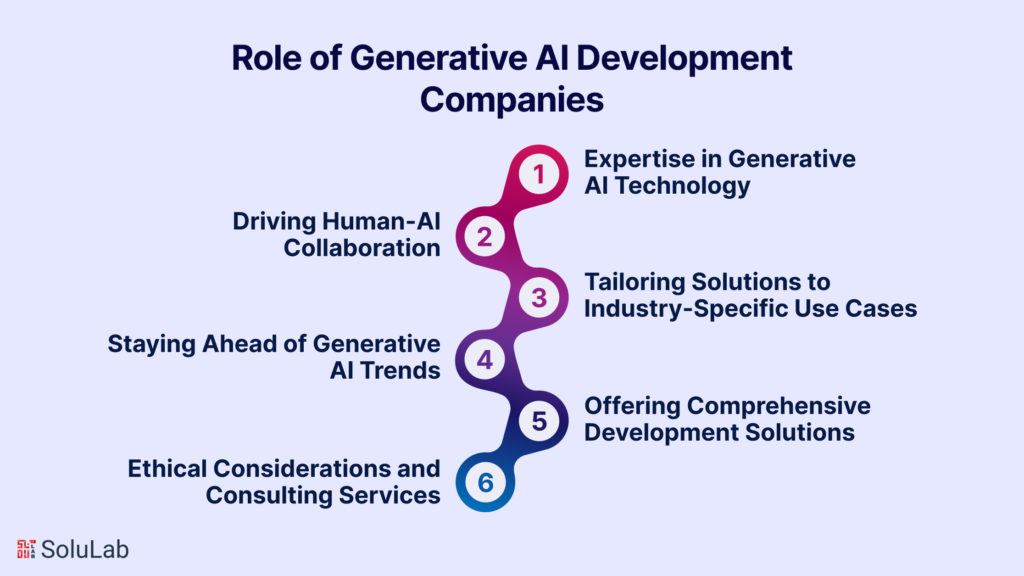
Generative AI development companies play a pivotal role in addressing the evolving needs of industries in the era of artificial intelligence. As businesses increasingly leverage Generative AI technology to enhance creativity and streamline processes, these companies become essential catalysts for innovation and progress.
1. Expertise in Generative AI Technology
- Generative AI development companies possess specialized knowledge in cutting-edge Generative AI technology, ensuring that businesses can tap into the full potential of these advancements.
- Their expertise extends to the intricate workings of Generative AI tools and models, allowing for the seamless integration of these solutions into diverse industry frameworks.
2. Driving Human-AI Collaboration
- Fostering effective collaboration between Generative AI and human creativity is a nuanced challenge. Development companies bridge this gap by crafting solutions that empower human-AI synergy.
- They design Generative AI models that complement human capabilities, fostering a harmonious partnership where technology augments and enhances creative processes.
3. Tailoring Solutions to Industry-Specific Use Cases
- Understanding the unique demands of various industries, Generative AI development companies tailor solutions to specific use cases, be it in healthcare, finance, or creative arts.
- By customizing Generative AI applications, these companies address industry-specific challenges, maximizing the impact of AI on operational efficiency and creativity.
Related: 10 Ways Generative AI is Revolutionizing Healthcare
4. Staying Ahead of Generative AI Trends
- The landscape of Generative AI is dynamic, with trends evolving rapidly. Development companies play a crucial role in staying ahead of these trends, ensuring that their clients benefit from the latest advancements.
- Proactive adaptation to emerging Generative AI trends positions businesses to maintain a competitive edge in their respective sectors.
5. Offering Comprehensive Development Solutions
- Generative AI development companies provide end-to-end solutions, encompassing everything from ideation and prototyping to deployment and maintenance.
- This comprehensive approach streamlines the implementation of Generative AI, reducing the burden on businesses and enabling them to focus on leveraging the technology for strategic goals.
6. Ethical Considerations and Consulting Services
- Addressing ethical concerns related to Generative AI is a crucial aspect of development. Companies in this domain often offer consulting services, guiding businesses on responsible AI practices.
- Their role extends beyond technical expertise to encompass ethical considerations, ensuring that Generative AI is deployed with a mindful approach to societal impact.
What are the Essential Skills for Generative AI Developers?
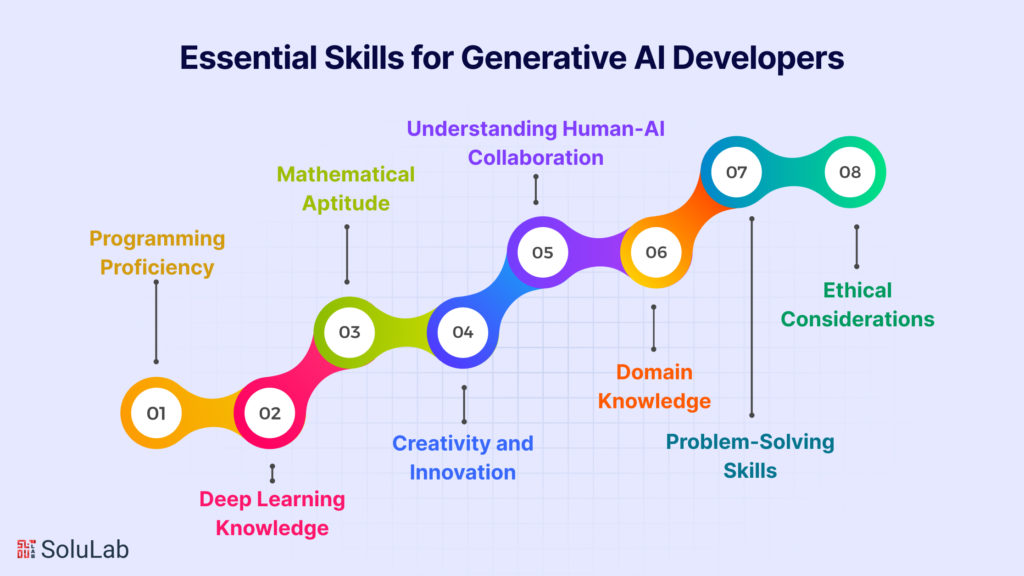
To excel in the dynamic field of Generative AI development, developers must possess a diverse skill set that extends beyond traditional programming. The essential skills for Generative AI developers encompass technical expertise, creativity, and a deep understanding of the collaboration between Generative AI and human creativity.
-
Programming Proficiency
Generative AI developers should have a strong foundation in programming languages such as Python, TensorFlow, and PyTorch. Proficiency in these languages is crucial for implementing and fine-tuning Generative AI models.
-
Deep Learning Knowledge
A comprehensive understanding of deep learning principles is essential. Developers must grasp concepts like neural networks, backpropagation, and optimization algorithms to effectively design and train Generative AI models.
-
Mathematical Aptitude
Strong mathematical skills, particularly in linear algebra, calculus, and probability, are vital. These skills underpin the algorithms and statistical models used in Generative AI development.
-
Creativity and Innovation
Generative AI is at the intersection of technology and creativity. Developers should possess a creative mindset to push the boundaries of AI-generated content and explore innovative applications.
Understanding Human-AI Collaboration
Successful Generative AI developers understand how to facilitate meaningful collaboration between AI and human creativity. This involves developing models that augment human capabilities rather than replacing them entirely.
-
Domain Knowledge
Depending on the application, developers should have domain-specific knowledge. Whether it’s art, music, language, or other fields, a deep understanding enhances the ability to create relevant and impactful Generative AI solutions.
Read Also: Generative AI in the Manufacturing
-
Problem-Solving Skills
Generative AI development often involves tackling complex problems. Developers must be adept at breaking down challenges, devising creative solutions, and iterating on models to achieve optimal results.
-
Ethical Considerations
Awareness of ethical implications is crucial. Generative AI developers should prioritize responsible AI practices, considering issues like bias, fairness, and the potential societal impact of their creations.
Conclusion
In navigating the evolving landscape of Generative AI technology, the delineation between artificial intelligence and human creativity is a pivotal concern. As Generative AI models and tools continue to advance, the imperative lies in orchestrating a symbiotic relationship between the ingenuity of human minds and the computational prowess of AI. SoluLab emerges as a trailblazer in this paradigm, providing cutting-edge Generative AI development solutions.
The delicate balance between Generative AI and human creativity hinges on thoughtful collaboration. While Generative AI offers unprecedented capabilities to generate content, ideas, and designs, it is paramount to recognize its role as a tool rather than a replacement for human innovation. SoluLab, as a Generative AI development company, exemplifies this synergy, fostering an environment where human-AI collaboration amplifies creative outputs.
Exploring Generative AI use cases, SoluLab navigates diverse industries, harnessing the technology to streamline processes, enhance efficiency, and unlock novel possibilities. The company’s Generative AI consulting services underline a commitment to guiding clients in harnessing the technology responsibly, ensuring that AI augments human creativity rather than supplants it.
FAQs
1. What is Generative AI, and how does it differ from traditional AI?
Generative AI refers to technology that produces content, mimicking human creativity. It diverges from traditional AI by creating original outputs rather than relying solely on predefined patterns.
2. How can Generative AI technology enhance human creativity?
Generative AI tools empower creators by offering new perspectives, automating routine tasks, and fostering collaborative efforts, ultimately expanding the boundaries of human creativity.
3. Where is the line drawn between Generative AI and human creativity?
The line is defined by the synergy between Generative AI models and human input. While AI generates content, human creativity guides the process, ensuring a harmonious collaboration.
4. What are the key use cases for Generative AI in creative industries?
Generative AI finds applications in content creation, design, music composition, and more. Its versatility contributes to novel solutions across various creative domains.
5. What trends are emerging in the Generative AI landscape?
Trends include personalized content generation, improved natural language processing, and enhanced collaboration between Generative AI and human creators.
6. How can SoluLab contribute to Generative AI development solutions?
SoluLab, as a leading Generative AI development company, specializes in crafting innovative solutions. Their expertise lies in leveraging Generative AI to address specific industry challenges.




